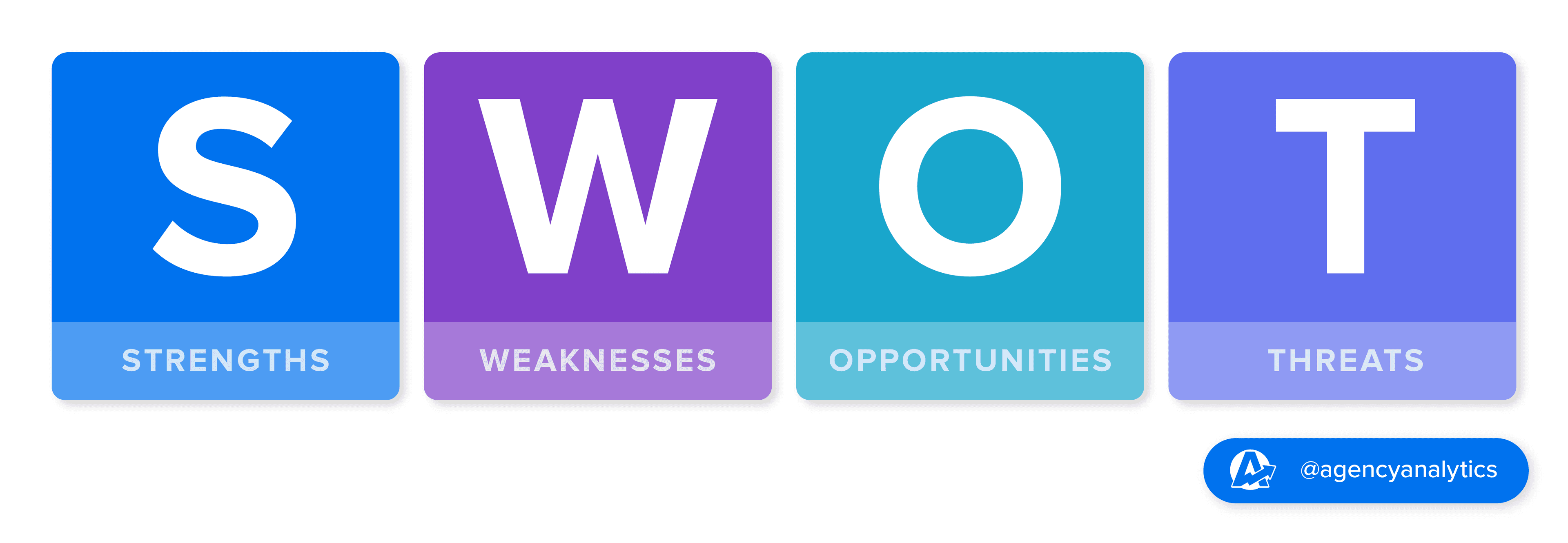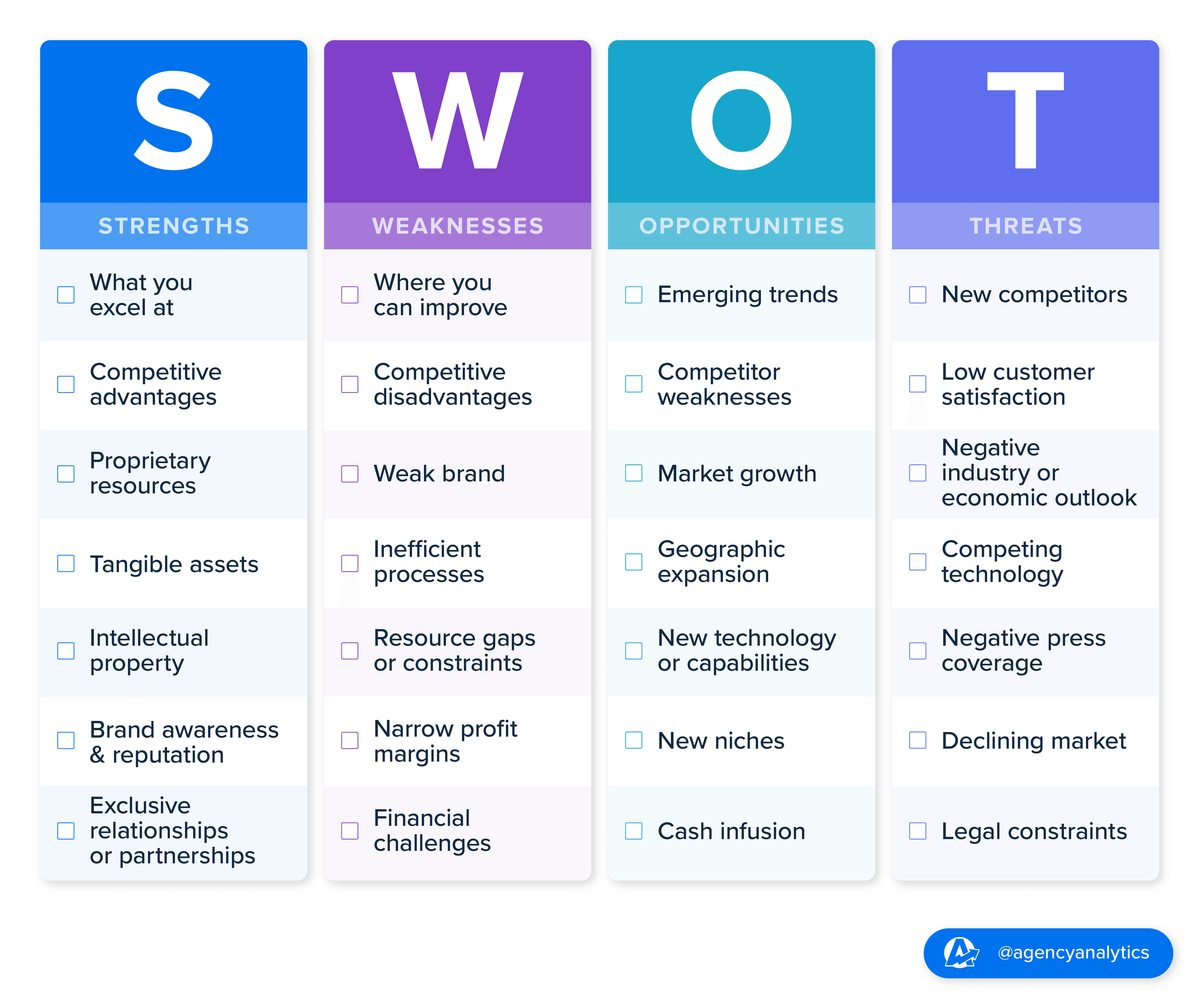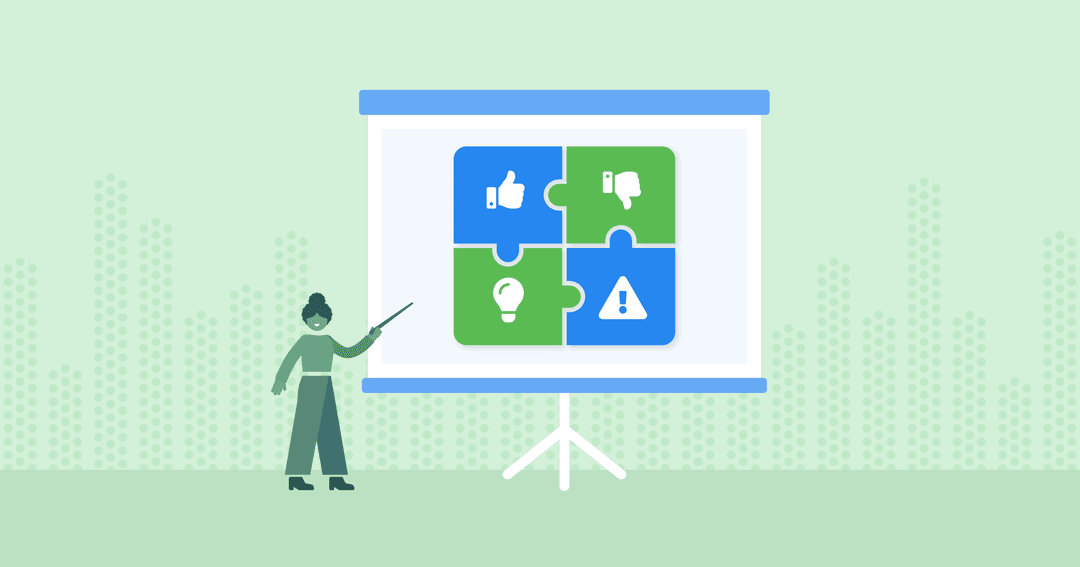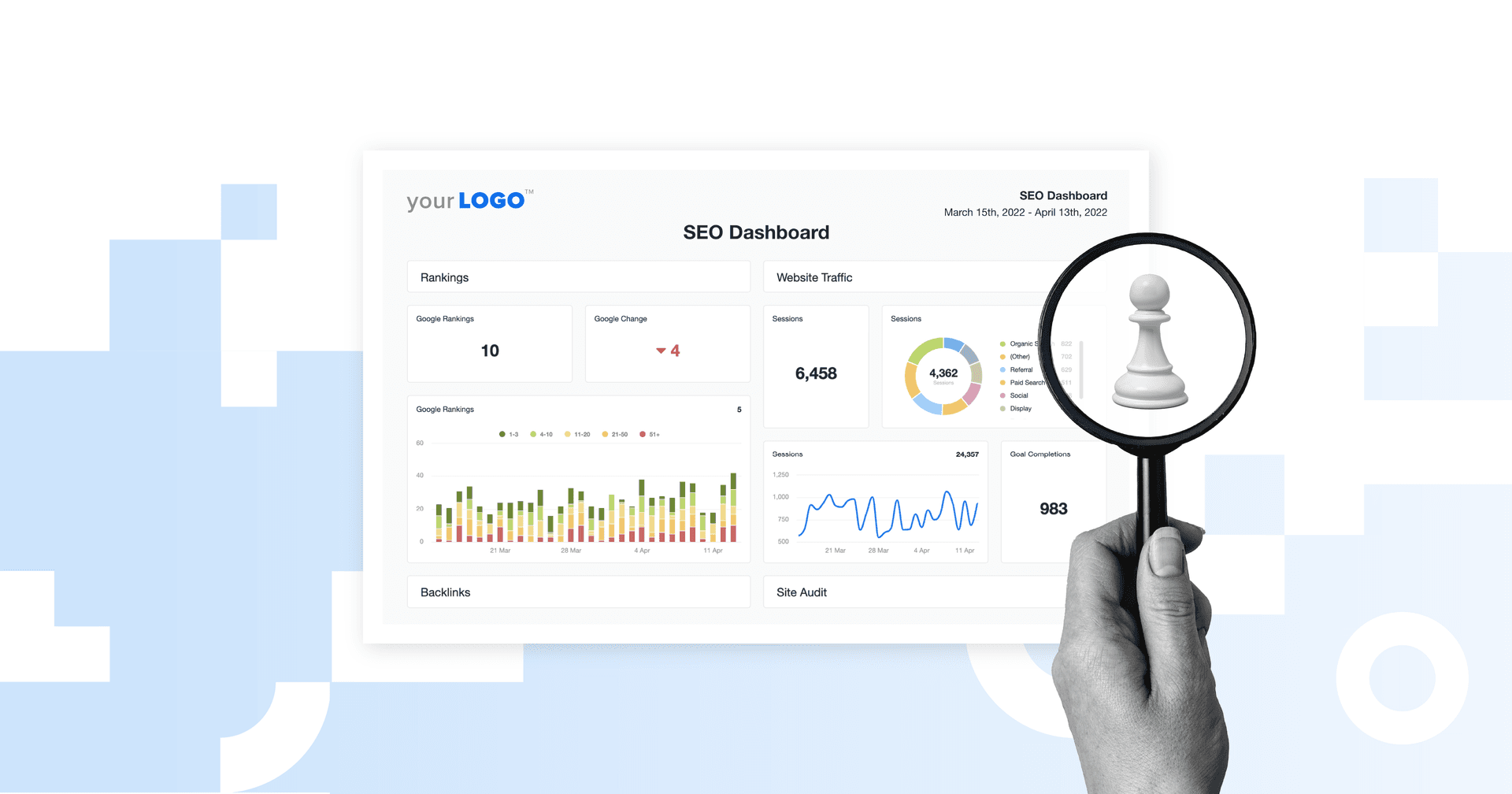Table of Contents
QUICK SUMMARY:
A SWOT Analysis is a strategic planning tool for identifying Strengths, Weaknesses, Opportunities, and Threats in business competition or project planning. It offers a comprehensive overview of an organization's internal capabilities and external market conditions. This article guides marketing agencies in conducting a detailed SWOT Analysis, providing a clear, structured approach, a free SWOT analysis template and an example specific to marketing agencies.
Running a marketing agency in a complex and rapidly shifting environment is no small feat. Every decision, big or small, influences an agency's trajectory. Amidst rapid changes in technology, competition, and consumer behavior, how does an agency stay ahead of the curve and make informed, strategic decisions? Enter the timeless and robust tool known as the SWOT analysis.
A SWOT analysis is a practical tool that breaks down complex information into manageable parts. It identifies the strengths and weaknesses within the agency as well as the opportunities and threats from outside. This clarity is essential for planning, decision-making, and strategic growth.
Many agencies focus too much on pure revenue generation without having a full roadmap in place. It's essentially trying to go from point A to point B, only knowing the location of both points. A proper SWOT analysis is like unlocking the GPS tool that allows you to build the best growth route for your company.
Emerson Guerrero, CEO, Orbis Marketing
So, for those who stand at the drafting table of their agency, looking out at the intricate blueprint of possibilities and uncertainties, this guide offers a steadying hand. It's like a master architect sharing insights and wisdom, ensuring that the construction is structurally sound and a testament to innovation and vision.
Equip yourself with this strategic tool, and let's lay the foundation for success that's as unique and well-crafted as the agency you design.
Understanding the SWOT Analysis in an Agency Context
Within our context, a SWOT analysis refers to taking stock of internal and external factors that could impact your agency’s growth.
Strengths—What are we exceptionally good at? What are our key competencies?
Weaknesses—What can’t we do quite as well? In what areas don’t we have the expertise to assist our clients?
Opportunities—How can we grow our agency business further by expanding into adjacent fields we have experience with?
Threats—What trends and possibilities have the potential to impact our brand name, revenue, and profitability negatively?
A SWOT analysis acts as a filter, helping us whittle down our niche to a singular industry or service that aligns perfectly with our strengths. It tells us where to add value for our clients and where to exit.
Michael Shieh, Revenue Marketing, Starbridge
To help us understand better, let’s conduct a hypothetical SWOT analysis for a hypothetical agency, ConTech Creations.
A Step-by-Step SWOT Analysis Breakdown for a Hypothetical Agency
ConTech Creations is a content marketing agency for VCs and SaaS companies—servicing startups, growth-stage, and enterprise clients. They’re a major player in the SaaS and technology content space.

Let’s carry out a pretend SWOT analysis example for ConTech Creations:
Strengths
First, we’ll assume that this agency gets content marketing—they really do, and they’ve built an A-class team, starting from the founder who’s led content at a publicly-listed company (HubSpot, Salesforce, VMware, or SAP), etc., and when staff does move on to new roles, this group of alumni ends up leading content strategies at growth-stage startups. They’re really that good.
Secondly, our hypothetical friends have built a reputation in the startup ecosystem among early-stage founders. When these startups decide to get serious with content, ConTech is their go-to solution.
Weaknesses
While ConTech has a good grip on organic content, there's no reason to assume they can easily branch out into PPC, design, and technical SEO. They have struggled to build this in-house function and are concerned that expanding their breadth of offerings will split their focus and reduce service quality overall.
Opportunities
If ConTech chooses to address and fortify their weaknesses, it’s possible to convert them into opportunities. They could consider breaking into PPC, search optimization, and PR by upselling their existing clients into these enhanced packages. These adjacent services could easily double their revenues within 2 - 3 years.
Threats
As venture funding dries up, a majority of ConTech Creations’s customers (venture-funded startups) may opt to either hit the brakes on organic content production, hire an in-house team, or channel those funds to PPC exclusively.
Likewise, as AI-generated content proliferates the industry, more of ConTech Creations’s customers and potential clients may opt to experiment with AI. Although there’s no guarantee they’ll stick with it, it might cause a short-term drop in revenues.
By running this hypothetical SWOT analysis, even at a basic level, you can see how the SWOT framework identifies the internal and external factors that will influence the agency’s business strategy.
In order for our agency to grow, we need to be aware of what we're good at, where we can grow, where our weaknesses lay, and what could harm us. It's all too easy for agencies to fall into the trap of focusing solely on day-to-day client deliverables without taking the time to lift your head and think strategically.
Jack Fenwick, Head of Marketing, Squidgy
Benefits of Conducting a SWOT Analysis for Your Agency
Think of a SWOT analysis as a pilot’s pre-flight plan or a coach’s pre-game routine that helps players understand their opponents, their playing styles, known tactics and tricks, and how to outmaneuver them.
A SWOT analysis helps you understand where you stand in an ever-changing industry so you can pitch effectively, attract high-quality, best-fit clients, and avoid splitting your focus, all while making the most money possible.
Identifying Growth Opportunities
Branching out into adjacent verticals is one of the easiest ways to grow your agency’s revenues.
All too often, agencies are so completely focused on the day-to-day, putting out fires, and trying to retain existing customers that they don’t even have time to think of new business.
Understanding the "opportunity" portion of a SWOT analysis can be extremely beneficial when it comes to expanding services.
Emerson Guerrero, CEO, Orbis Marketing
A SWOT analysis helps you take stock of growth opportunities that might be right around the corner, just waiting to be discovered.
For instance, a PPC advertising agency looking to get more customers can easily branch out into media buying, SEO, and content marketing and upsell those services to customers looking to diversify their customer acquisition; a branding and design consultancy has better chances of successfully breaking into web design, video production, and public relations by working with their existing clients.
Likewise, marketing agencies that offer complementary services can enter into referral partnerships, promote their brand together, and pool their resources for growth experiments, influencer marketing campaigns, and brand sponsorships.
Understanding what your agency is really good at–and the areas where it could use reinforcements–helps illuminate a path forward.
Understanding the Current Market Position
Your market includes your agency, competitors, and all the customers buying your services. A SWOT analysis will help you observe when to:
Raise prices if your services are underpriced compared to your peers
Lower prices when customers in your niche are looking for expenses to cut
Experiment with new technology, or incorporate it with your service experience
Target a different demographic or customer niche
Change your strategy from purely acquisition to retention-first
Your agency does not operate in a vacuum, so having a clear sense of where the agency stands in the current market is essential.
As a growing agency, it is important we use our time and resources carefully, and our SWOT analysis allows us to identify exactly what it is we’re good at, why people choose to work with us, and ultimately where to focus our efforts as an agency.
Jack Fenwick, Head of Marketing, Squidgy
Preparing for Future Challenges and Opportunities
Today, marketing agencies are facing more challenges in the external environment than ever. Currently among the front runners, we have:
ChatGPT is proving to be a semi-reliable content machine clients can rely on in-house vs. agencies
Apple’s privacy push has slashed the average mobile advertiser’s ROAS by 38%
Google Ads CPL has increased by an average of 19% for 91% of industries for no commensurate growth in CTR
A SWOT analysis helps marketing agencies build internal processes to respond to market trends in their industry, create a plan to mitigate their company’s weaknesses, and diversify their customer base, marketing channels, and growth tactics.
The digital marketing landscape is shifting more than ever with the introduction of things like AI, and whilst these things can be of benefit, they also provide a level of uncertainty in the industry, so it’s important we do our utmost to demonstrate our value.
Jack Fenwick, Head of Marketing, Squidgy
Running a SWOT analysis is a strategic technique that guides the agency’s attention to internal factors (human resources gaps, pricing strategy, etc.) and external factors (economic and market trends) that could impact future revenue, clarifying the business strategies necessary to navigate them.
When To Run a SWOT Analysis
Knowing when to run a SWOT analysis is almost as crucial as knowing how to do it. The timing can significantly impact the insights you gain and the decisions you make. Here are some specific scenarios when conducting a SWOT analysis can provide immense value to your agency:
At Specific Stages in the Agency Lifecycle
Conducting a SWOT analysis at various stages in the agency life cycle provides insights tailored to the unique challenges and opportunities present at each phase.
Startup Phase: During the early stages of the agency, a SWOT analysis provides a blueprint to help a growing agency build a sturdy foundation.
Growth Phase: As the agency begins to grow, a SWOT analysis aids in channeling that growth effectively. It’s like checking the build against the plans to make sure you’re not leaning too far in one direction.
Maturity Phase: An agency in its maturity phase needs to sustain its success and possibly innovate to keep ahead of competitors. A regular SWOT analysis helps you decide if you need to renovate the entire building or simply freshen up the paint.
SWOT isn't a one-size-fits-all approach but a flexible tool that adapts to the specific stage of the agency's life cycle. It guides the agency through the ebbs and flows, offering timely advice and direction.
Entering a New Niche or Market
When you’re expanding into another niche or an entirely new market, a SWOT analysis helps you determine what your agency needs to succeed, build up those capabilities, craft a reasonable offer, and choose the unique approach you’ll bring to the market. A SWOT analysis helps you:
Position your brand and construct a unique angle for services
Choose a customer acquisition channel, e.g., referrals from existing customers, community sponsorships, brand partnerships, paid ads (knowing how to allocate budget between Facebook, Instagram, Twitter, etc.)
Determine a competitive pricing strategy
Build a dream team—that is, figure out which functions your existing employees are good (and not-so-good) at and which roles you need to supplement
Create an ideal customer persona, down to their company size, revenues, budget, psychology, etc.
Once we niched down using a SWOT analysis and dug into problems specific to one industry, we found that a lot of the value an agency can provide actually falls outside of just marketing and leads. There are infinite ways we can make the lives of business owners easier and more profitable.
Michael Shieh, CEO, Local Search Technologies
Preparing to Sell the Agency or Attract Investors
An exit strategy is more than just a plan to sell or transition an agency; it's a blueprint that ensures that the business is prepared for the future, whether that involves a sale, merger, or another form of transition.
When planning to sell or transition the agency, a SWOT analysis helps understand the agency's intrinsic value and how to present it to potential buyers or investors. According to agency marketplace Barney, a digital agency with at least $5M in annual profits can expect to sell for anywhere between 8 - 10X EBITDA (i.e., earnings before taxes, depreciation, and amortization).
A SWOT analysis plays a vital role in building a robust and thoughtful exit strategy, and here's how:
Understanding the Agency's Value: A SWOT analysis evaluates the agency's intrinsic value by assessing its strengths and weaknesses. Knowing the true value gives you a fair position during negotiations.
Identifying Potential Buyers or Successors: External factors in a SWOT analysis include competitors, market trends, and potential buyers or successors. It's a bit like knowing who's attending a party, so you can dress to impress the right audience.
Preparing for Market Changes: Understanding market dynamics and how they may affect the agency’s value and attractiveness enables you to time the exit strategically, so you're not caught off guard by sudden shifts.
Mitigating Risks: Knowing your agency's weaknesses allows you to address potential obstacles that might hinder a successful exit. From legal complications to talent retention concerns, addressing these issues proactively means there won't be any nasty surprises when it's time to make a move.
Responding to Market Changes and Competitor Actions
While the agency's business model can remain stable over long periods, a competitor might suddenly launch an offer or innovation that threatens to take away market share from its peers. Instead of making changes to your business model reactively, a SWOT analysis helps you take a strategic approach by asking questions like:
What can we still do well compared to our evolving peers? How do we stay competitive, maintain a loyal customer base, and reinforce our competitive advantage? (Strengths)
In what areas are we lagging behind? This includes technical expertise, market positioning, branding, advertising, etc. (Weaknesses)
How can we close the gap or leapfrog our competitors completely? (Opportunities)
Are there any (especially unseen) obstacles that could negatively impact our profitability, revenues, and market share? (Threats)
The SWOT analysis framework serves as a flexible guide to responding to changes in your industry that can disrupt your business model, hurt your brand’s viability, or pull away customers to experiment with your competitors—it helps you determine a course of action by understanding your situation clearly.
A Note on SWOT Analysis Disadvantages
While running a SWOT analysis is almost always worth the time investment, there are some drawbacks of this type of analysis to keep in mind as well:
Risk of oversimplifying complex problems and neglecting to consider the big picture
Can be time-consuming to gather all the data necessary to run an accurate SWOT analysis
Must be based on quality data in order to be accurate
Must be repeated on a regular basis to account for market changes/surprises
Can lead to data overwhelm when over-analyzing tough decisions
Cannot realistically be expected to anticipate all future threats or opportunities
Turning SWOT analyses into make-work projects instead of a strategic planning technique.
When deciding whether or not to conduct a SWOT analysis, weigh out the pros and cons of the individual situation and make your decision accordingly.
Do it, and use it to inform your strategic direction, don't use it as a tick-box exercise and put it in a drawer for the next six months.
Jack Fenwick, Head of Marketing, Squidgy
How To Do a SWOT Analysis
The SWOT matrix covers your agency’s strengths, internal weaknesses, competitive advantages, future opportunities, and external threats, offering a complete picture of your agency's standing in the market. This section will walk you through a focused, step-by-step process to conduct a SWOT analysis for your agency's growth.

Determine Your Objective
First, you need to define the most important goal you’re trying to achieve by your SWOT analysis. Some examples include:
Identify growth opportunities to increase revenues by 25% within the next 12 months
Automate our client onboarding process
Develop creative ideas for building the agency’s brand
Launch a new product line or service offering that will increase client stickiness
Reduce customer churn by 50% over the next two quarters
Increase email open rates and click-through rates by 10% and 15% respectively across our customer base
Reduce our customers’ bounce rates, cost per lead (CPL), and cost per action (CPA) by 15% over the next 12 months
RELATED: 15 Most Important PPC Metrics To Maximize ROI
That way, your SWOT analysis results become part of your agency’s strategic plan and goal-tracking framework for measuring your agency’s success.
Assess Strengths
What’s your agency really good at? What do you do better than your peers?
A SWOT analysis template helps you identify internal factors where your agency excels, including:
Unique Service Offerings: Offering unique or specialized services that differentiate the agency from competitors.
Skills, Experience, and Expertise: For instance, in the SWOT analysis example for ConTech Creations, their ability to create top-notch content for a specific industry was one of their greatest strengths.
Location: If geography plays a role in client acquisition, physical proximity to the client base can be considered a great strength. For example, an agency based in San Francisco may be more likely to win business from software companies in the area compared to an agency based in South Dakota.
Proprietary Technology or Tools: Some agencies develop or utilize unique technology or tools that set them apart from the competition. For instance, a streamlined client onboarding and reporting process utilizing AgencyAnalytics is a strength compared to agencies who waste hours upon hours pulling together reports manually.
Brand Awareness and Social Media Presence: How often do your key executives post on LinkedIn? How many interactions do they get per post? If it's substantial, it can serve as another channel for inbound growth and brand promotions.
Your aim at this stage is to take stock of any resources and tactics that can help your agency optimize business performance and drop those that are pulling focus away from your company's strengths.
We used to offer more services than we do now. A SWOT analysis allowed us to analyze our strengths, and be honest about what we're great at, not just good at. As a result, the services that fell into just 'good' were dropped, leaving three services we believe we're great at, streamlining our agency and focus.
Jack Fenwick, Head of Marketing, Squidgy
Uncover Weaknesses
Your agency’s weaknesses are the patterns and internal factors in your business model, customer base, and pricing structure that hinder your effectiveness and growth. A good SWOT analysis will highlight areas of concern, including:
Slow Growth: How fast are you adding new clients/upselling them value-added packages?
Low Profitability: Agency profit margins usually average between 11 - 20%, and single-digit margins are a tell-tale sign of trouble. A slimmer profit margin gives you less wiggle room to respond to changing market conditions, scale up customer acquisition, invest in new technology, etc.
High Customer Concentration: High-ticket clients are a dream to work with, and any agency owner would prefer a single $1M/yr client compared to a thousand customers that pay you $1k yearly (i.e., $83 monthly). But, if you don’t diversify, one or a few of your high-ticket customers putting spending on hold can eat into your funds, require laying off staff, or shutting down because of negative margins.
Lack of Innovation or Inefficient Processes: Are you staying on the cutting edge of tech in your industry, or are you still sending clients monthly reports via fax (or pigeon)? If you are, we’d recommend checking out AgencyAnalytics’ monthly reporting template.
Split Priorities: Trying to be everything to everyone risks diluting your agency's core competencies and can confuse your target market. Specialization often trumps generalization.
We acquired an agency that used to provide services for too many industries with too many different services. The SWOT analysis helped us decide that we wanted to focus specifically on Tree Service businesses which allowed us to exit the agency price war.
Michael Shieh, CEO, Local Search Technologies
Consider Opportunities
What are the moves you can make to grow your revenues, profitability, and market share? Oddly enough, your agency’s weaknesses are often your biggest opportunities since they offer definite changes you can make to reinforce your agency’s position.
Tapping Into Emerging Markets or Niches: Identifying emerging markets or specialized niches offers a chance to get ahead of competitors. These are areas where demand is increasing, but competition may be low.
Expanding Within Existing Verticals: If you have a few high-ticket clients contributing most of your revenue, you can use their case studies and customer stories to market to their industry peers and spread your revenue base.
Embracing Innovation and Automating Repetitive Tasks: An agency management suite like AgencyAnalytics can help you automate your monthly reporting, generating fully customizable client dashboards (in seconds), integrate with the rest of your agency stack, and–best of all–white label to suit your branding.
RELATED: What To Include in a Digital Marketing Report to Wow Clients
We like to have our leadership get together once a year with their own rough SWOT built out - this allows us to see clear synergies in where we are at. From there, we are able to talk through where opinions may differ and ultimately end up with a united SWOT analysis that brings in our key viewpoints across agency channels.
Emerson Guerrero, CEO, Orbis Marketing
Identify Threats
What are the trends and possibilities that have the potential to hurt your agency’s growth, revenues, and profitability in the near future? They’re not yet a problem, but they have the potential to be within anywhere from a quarter to several years down the line. In an agency context, threats can either be internal or external factors, including:
Recession: During times of economic uncertainty, companies tend to lay off staff, put agency engagements on hold, and bring their operations in-house to save on costs. If your customer base is concentrated in a particular industry (startups, technology, food and beverage, fashion, etc.), an industry-wide downturn will be catastrophic for your revenues.
New Technology: This can take the form of competitors and industry peers deploying solutions built with AI, NLP or offering other tech-enabled services that demonstrate a higher ROI than the rest of the industry.
Increased Competition: Increased competition might come from established rivals expanding their service offerings, new players entering the market, or even technological advancements that level the playing field.
Legal Constraints: New regulations can prohibit certain marketing tactics or lead to hefty fines if you continue to use them.
Negative PR: In the real-time age of social media, your agency’s reputation can tank as fast as a dissatisfied client with a large following calling you out to their customer base. Do you have NDAs in place to protect sensitive contracts and work arrangements?
We like to run our SWOT analysis on our business as a whole. From operations to go-to-market to finance and invoicing, the biggest items are included and prioritized simultaneously based on how much ROI on time we think that activity is. It becomes a game of deciding whether we should do it ourselves or hire someone to help.
Michael Shieh, CEO, Local Search Technologies
Free SWOT Analysis Template
When your agency is facing a tough decision or a challenging period–or just trying to decide where to focus your resources next–running a SWOT analysis provides much-needed clarity and shines a light on a path forward.
Remember, how you complete a SWOT analysis is less important than what you take away from it.
We're fairly old-school when it comes to conducting a SWOT analysis, it typically involves the full team, a big table, a roll of paper and a sharpie.
Jack Fenwick, Head of Marketing, Squidgy
A SWOT analysis isn't just a one-off exercise you dust off during your agency's annual retreat. It's an important, ongoing part of your business plan that needs to be revisited regularly.
By running SWOT frameworks, you make informed business decisions that identify strengths and weaknesses in real time. With these insights, you are better equipped to counteract negative elements while maximizing new market opportunities.
The four elements of the SWOT matrix offer a visual representation of your agency’s current standing and a great starting point when your team is feeling stuck.
Need help getting started? Use this free SWOT analysis template.👇
If you’d like to add more opportunities to your SWOT analysis, try sharing detailed, white labeled reports with clients to demonstrate campaign success. Sign up today for a 14-day free trial with AgencyAnalytics.

Written by
Churchill is an experienced product-led content marketer helping SaaS companies with their content needs.
Read more posts by Churchill LeonardSee how 7,000+ marketing agencies help clients win
Free 14-day trial. No credit card required.






